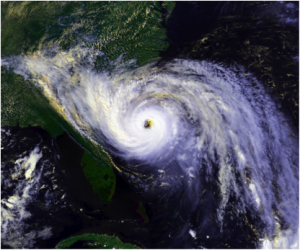Hurricanes and Social Media: How the Two Worlds Collide
August is here: school is back in session and we’re in the peak of hurricane season. A mighty hurricane does not spare anyone: those on the coast must be prepared for the storm surge and rip currents, while coastal residents and those further inland must be aware of heavy rainfall, high winds and tornadoes.
Most of us are probably aware of the basics of hurricane preparedness – charge your cell phones, stock up on batteries and candles, test your flashlights and be sure to pack an emergency supply kit. (find a complete list of necessities for your emergency supply kit on FEMA’s website.) It is also a good time to update emergency contact information, such as those for doctors’ offices, your insurance agent, local emergency management office, hospitals, utilities, police and fire departments. Develop an emergency plan specific for your family and identify the specific risks you face where you are.
This is fine and all. But where’s the social media piece? Well, enter John Copenhaver.
Mr. Copenhaver is a former FEMA Director of Region IV and President of Disaster Recovery Institute International. He is currently CEO of Contingency Management Group, Inc. His 2011 TEDx Peachtree talk “Crisis Rethink” addressed broader goals for community disaster response. Copenhaver discusses how natural disasters are occurring more frequently and are draining FEMA’s already diminishing resources.
More frequent events paired with less government resources means natural disasters have a greater impact on affected communities. Therefore, we find ourselves relying more on private-sector help in the wake of natural disasters. Indeed, we need communities at the local level to not only be more prepared to deal with the aftermath of these storms, but also to do what they can to lessen the impact of these disasters before they happen. Effective mitigation requires that we understand the local risks and we invest in the long-term well-being of the community.
Communication is key. More resilient communities will require residents to play a larger role in mitigation efforts. Communities now use technology like Twitter and YouTube for communication and disaster assessment. We must look beyond elected officials and find community stakeholders in the private sector, such as grocery store owners, schools and homeowners that will pool resources and lead the community to a successful recovery.
Although it’s been a quiet hurricane season thus far, Mr. Copenhaver warns that storms get more active from August through mid-October as the ocean temperatures rise. His best advice for preparing for an upcoming storm is “Pay Attention. Listen to your local meteorologist when they’re giving advanced warning. Be Prepared. It doesn’t have to be a lot – have bottled water at your house, also batteries. Have a radio so if you lose power you can listen to emergency directives. It’s when you’re not receiving information that you’re in the greatest danger. Getting information is the key to being able to respond to a situation.”
James Kilgore has followed Copenhaver’s ideas on emergency response and disaster relief since he was a graduate student. Now a professor at York University in Toronto, James has been showing his students Mr. Copenhaver’s TED Talk with impressive results. He uses the three recommendations from Copenhaver’s talk – to refocus on community, to use technology to advance communication and to invest in community stakeholders – to open a dialogue with the students in his second year Fundamentals of Emergency Management class. He is impressed by the paradigm shift he has witnessed as his students see the issues of disaster relief with fresh eyes. A major part of their re-think of how to look at crises includes the importance of social networks in the fabric of our communities. The first thing his students now strive to do during a crisis is to get their social network back together & connect. Getting the message out during disaster response takes a top priority and social networks are an invaluable tool.
Lauren Lynn is a new arrival to Atlanta. She moved from Charleston, SC where she worked in arts management. Lauren lives in Lake Claire and enjoys exploring the neighborhood parks with her dog and children.


Leave a Reply